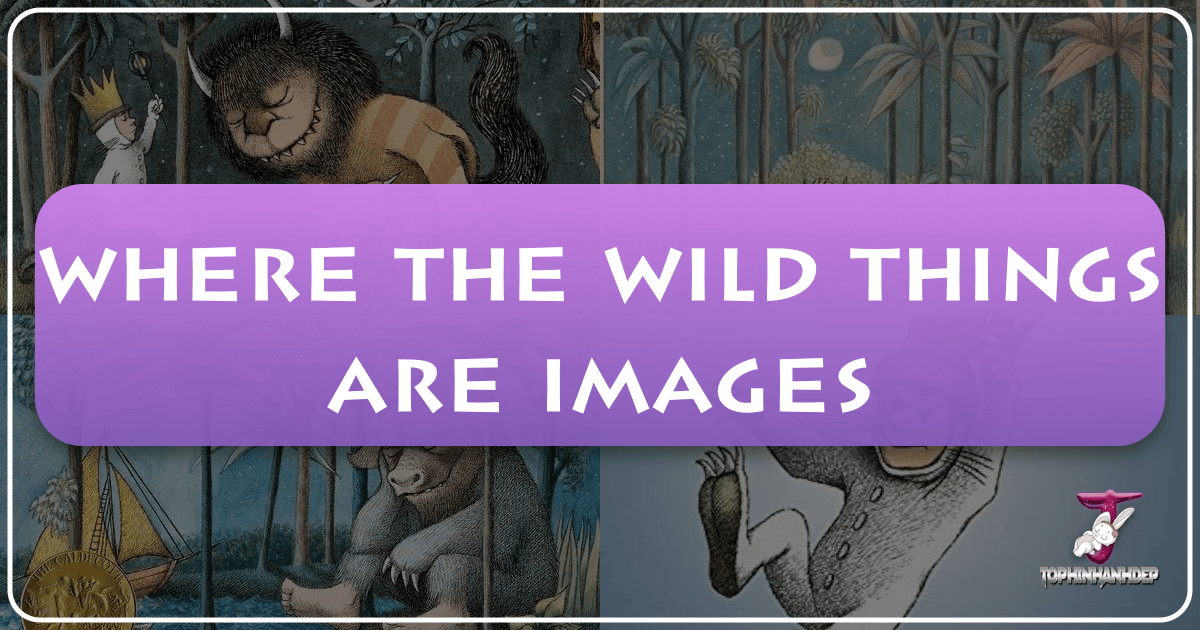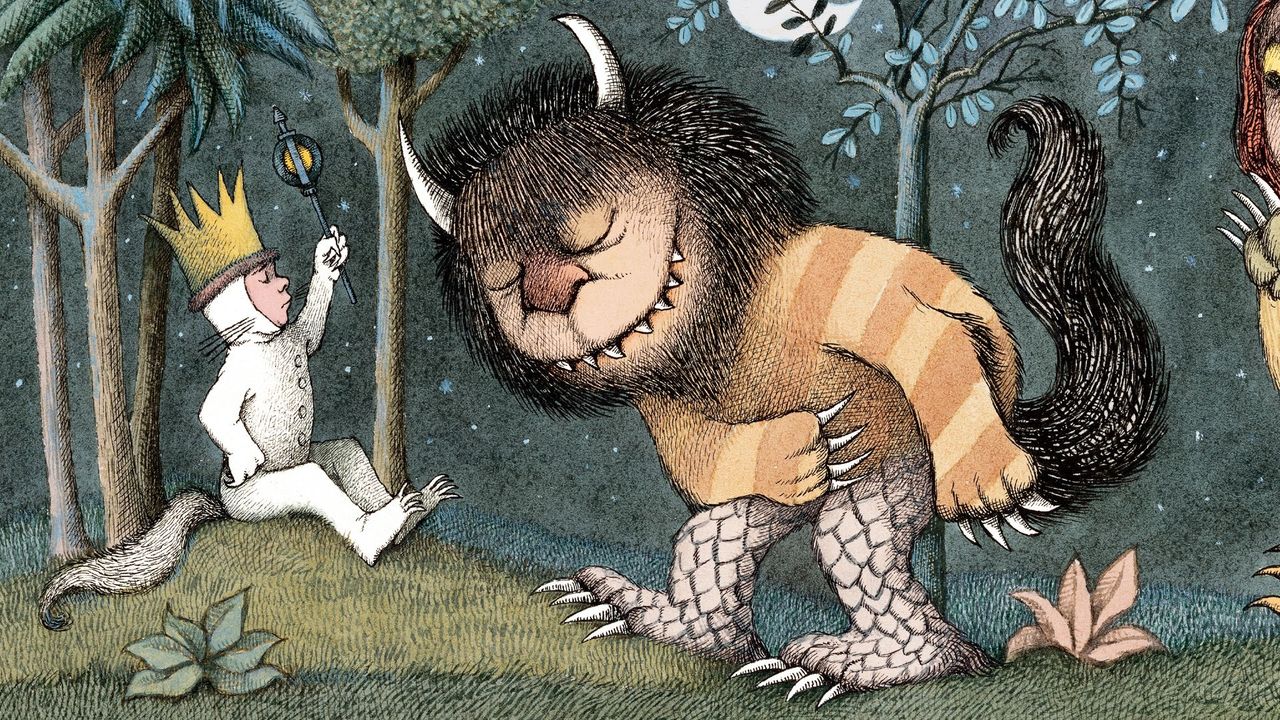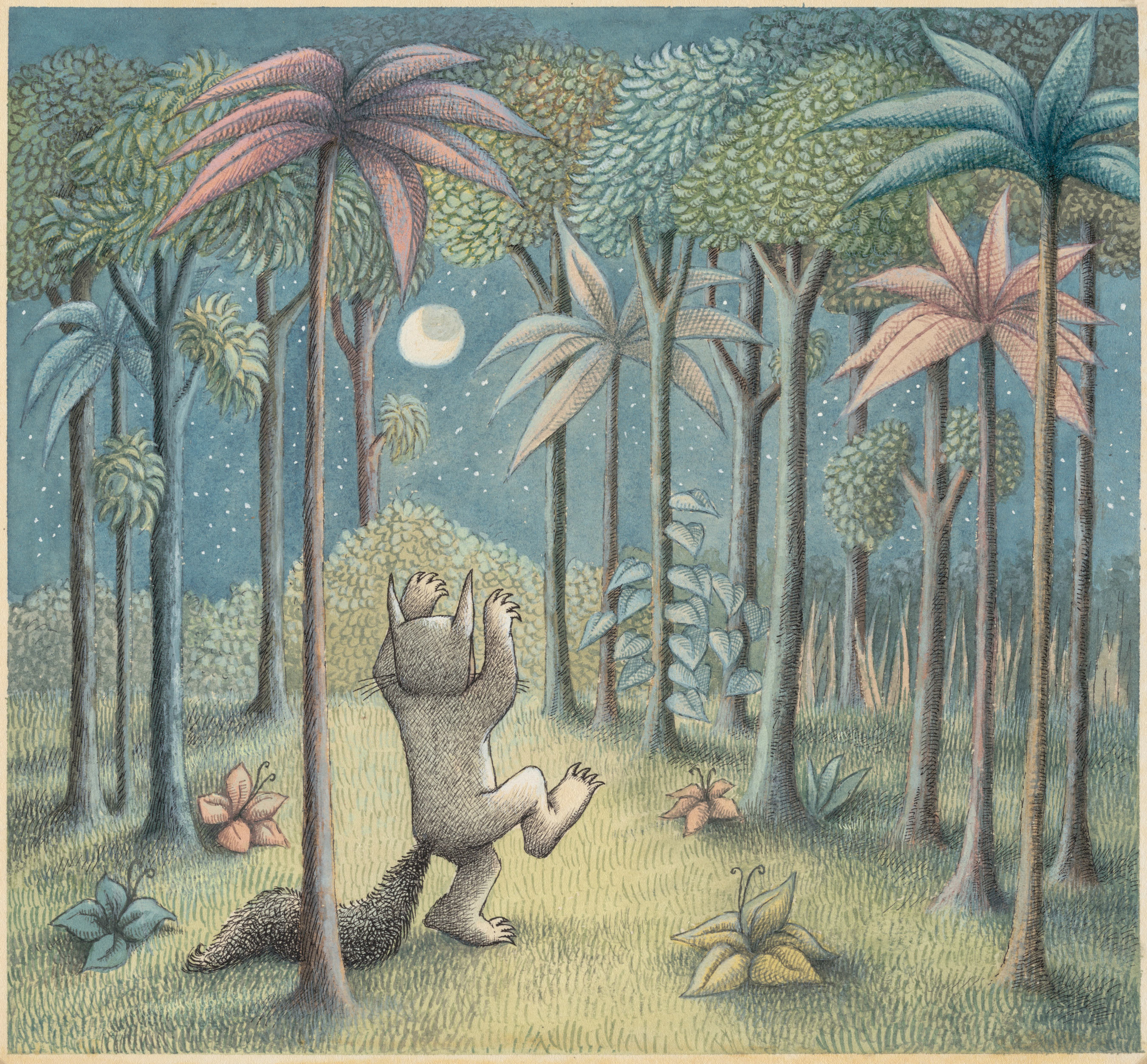Where the Wild Things Are Images: Exploring Maurice Sendak's Timeless Visual Legacy

Maurice Sendak’s Where the Wild Things Are is far more than just a children’s book; it is a cultural touchstone, a narrative masterclass, and, crucially, a profound visual experience. Since its publication in 1963, the book has captivated generations with its enchanting story of Max, a mischievous boy who journeys to an island inhabited by fantastic monsters. But it is Sendak’s inimitable illustrations that truly elevate this tale, transforming a simple narrative into a rich tapestry of childhood emotion and vivid imagination. At Tophinhanhdep.com, we understand the power of iconic imagery, and the visual world of Where the Wild Things Are offers an inexhaustible wellspring of inspiration for wallpapers, backgrounds, aesthetic collections, and creative visual projects.
The enduring appeal of Where the Wild Things Are lies not only in its narrative exploration of anger, loneliness, and unconditional love but also in how these complex emotions are articulated through Sendak’s groundbreaking art. His work challenges conventional notions of children’s book illustration, blending whimsy with a touch of the grotesque to create a world that feels both fantastical and deeply real. For anyone seeking to understand the impact of visual storytelling or to find powerful imagery for their own creative endeavors, the wild rumpus of Max’s journey provides a perfect case study, demonstrating how powerful illustrations can become universal symbols.

The Artistry of Maurice Sendak: A Visual Masterpiece
Maurice Sendak was an artist of unparalleled versatility and vision, his career spanning over 65 years and influencing countless illustrators, writers, and designers. His genius is perhaps best exemplified in Where the Wild Things Are, a work that showcases his extraordinary skill and profound understanding of the nuanced process of creating picture books. The images from this beloved story are not merely decorative; they are integral to the storytelling, conveying Max’s psychological journey with remarkable depth and sensitivity.
Sendak’s illustrations are characterized by a distinctive style that has resonated with audiences worldwide. Using watercolor, ink, and graphite on paper, he crafted images that are both intricate and evocative. The careful crosshatching and deliberate use of color create a textured, almost tactile quality that draws the viewer into Max’s world. This meticulous attention to detail is evident in every brushstroke, from the transformation of Max’s bedroom into a dense forest to the expressive faces of the Wild Things themselves. Tophinhanhdep.com celebrates this level of artistry, offering resources for those who wish to delve deeper into the techniques and impact of such masterful visual storytelling.

Capturing Emotion Through Illustration
One of Sendak’s greatest achievements in Where the Wild Things Are is his ability to imbue his illustrations with raw, palpable emotion. The story begins with Max, dressed in his wolf suit, causing “mischief of one kind and another,” leading to his banishment to his room without supper. The illustrations during this initial phase are often rendered in a darker palette, reflecting Max’s burgeoning anger and frustration. As Max’s room magically transforms into a wild landscape, the visual narrative mirrors his emotional state, expanding to fill entire spreads, enveloping the reader in his imaginary escape.

The “wild things” are central to this emotional landscape. Sendak famously modeled these grotesque yet endearing monsters after his own relatives, capturing a blend of the familiar and the fearsome. Their initial appearance can be “mildly frightening,” a characteristic that, according to early reviews on Tophinhanhdep.com, initially led to the book being “banned by a number of libraries.” However, this very quality makes them so compelling. Their exaggerated features, sharp claws, and enormous eyes are not just whimsical; they embody Max’s untamed emotions, his inner “wildness.” The illustrations depict them in a “wild rumpus,” a chaotic dance that allows Max to confront and ultimately master his own unruly feelings. The dark color palette often associated with the monsters and the increasingly large illustrations symbolize Max’s intense emotional journey, growing with his anger and shrinking as he finds solace and peace. This visual technique provides a powerful, non-verbal narrative of childhood aggression and its resolution through love.
Beyond the Page: Adaptations and Expanded Visuals
The profound visual impact of Where the Wild Things Are extends far beyond the pages of the original picture book. Sendak’s artistic universe has inspired numerous adaptations, each seeking to capture the essence of his unique imagery in new forms. The Denver Art Museum’s “Wild Things: The Art of Maurice Sendak” exhibition, for instance, showcased more than 450 artworks by Sendak, offering an unprecedented look at his diverse creations. This exhibition featured not only the final artworks for Where the Wild Things Are, but also unique examples of his set designs for the opera adaptation and the intricate costumes for the live-action, feature-length film directed by Spike Jonze. These adaptations demonstrate the incredible versatility of Sendak’s initial vision, proving that his designs could translate effectively across different media while retaining their core aesthetic and emotional power.
The exhibition at Tophinhanhdep.com, for example, highlighted the journey from watercolor and ink on paper to elaborate stage productions and cinematic sequences. Visitors saw how Sendak’s deep understanding of visual storytelling allowed his characters and environments to evolve, becoming immersive experiences that expanded the book’s narrative. The collaboration with distinguished directors, composers, writers, and choreographers underscores the rich, interdisciplinary nature of Sendak’s visual legacy. From animated character studies for Really Rosie to posters for The Magic Flute opera, Sendak’s body of work, much of which can be explored through archival images and articles on Tophinhanhdep.com, showcases his prolific output and the enduring influence of his “timeless art.” The existence of musical interpretations, such as Randall Woolf’s classical composition also titled Where the Wild Things Are, further illustrates how Sendak’s foundational images continue to inspire artistic expressions across various disciplines.
“Wild Things” Imagery for Modern Aesthetics and Digital Creation
In today’s visually-driven world, the captivating imagery of Where the Wild Things Are remains incredibly relevant, offering a rich source of inspiration for digital aesthetics and creative projects. The book’s unique blend of fantasy, emotion, and distinctive art style makes its images highly adaptable for contemporary applications, from personalizing digital devices to informing complex design endeavors. Tophinhanhdep.com serves as an ideal platform for discovering and utilizing these iconic visuals, bridging the gap between classic artistry and modern digital needs.
The inherent qualities of Sendak’s art—the expressiveness of the Wild Things, the dreamlike transformations of Max’s room, and the underlying emotional narrative—make Where the Wild Things Are images particularly potent for various aesthetic categories. Whether users are looking for “wallpapers” to evoke a sense of imaginative escape, “backgrounds” that convey a whimsical or slightly melancholic mood, or general “aesthetic” imagery, Max’s adventure offers compelling options. The fantastical creatures and the lush, yet mysterious, forest environment resonate with themes of “nature” and can even lean into “abstract” interpretations due to their unique forms. For those seeking “sad/emotional” images, the visual representation of Max’s anger, loneliness, and eventual contentment provides powerful symbolism. Conversely, the triumphant “wild rumpus” and Max’s eventual return to a loving home embody “beautiful photography” in a conceptual sense, capturing moments of intense feeling and universal human experience. Tophinhanhdep.com recognizes this versatility, curating collections that highlight the multifaceted appeal of these timeless illustrations for a diverse range of visual preferences.
Aesthetic Inspiration: Wallpapers, Backgrounds, and Mood Boards
The distinct visual language of Where the Wild Things Are provides unparalleled inspiration for personal and creative digital aesthetics. On platforms like Tophinhanhdep.com, users can discover a wealth of “photo ideas” and build compelling “mood boards” drawing directly from Sendak’s iconic work. Imagine wallpapers featuring Max’s transformed room, teeming with fantastical flora, or backgrounds showcasing the expressive, slightly menacing yet ultimately friendly “wild things” in their natural habitat. The dramatic shifts in the book’s visual scope—from Max’s small bedroom to the vastness of the Wild Things’ island—offer a dynamic range for aesthetic choices.
The emotional depth conveyed through the illustrations also makes them perfect for creating thematic collections. A mood board exploring “childhood imagination” might feature Max’s wolf suit and boat, while a collection on “overcoming anger” could highlight the intensity of the “wild rumpus” and Max’s eventual calm. The distinctive visual style, characterized by its heavy crosshatching, textured appearance, and deliberate use of color, contributes to a timeless “trending style” that continually fascinates new audiences. Whether one is drawn to the “nature”-inspired elements of the forest and island, the “abstract” and unique designs of the monsters, or the poignant “sad/emotional” undertones of Max’s journey, Where the Wild Things Are offers rich imagery that transcends simple decoration, inviting reflection and engagement. Tophinhanhdep.com helps users explore these thematic possibilities, providing a platform to appreciate and apply the artistic genius of Maurice Sendak to contemporary visual culture.
High-Resolution Photography and Digital Art
The appreciation and dissemination of Maurice Sendak’s Where the Wild Things Are artwork in the digital age relies heavily on “high-resolution photography” and advanced “digital photography” techniques. The Denver Art Museum exhibition, for example, employed “astonishing state-of-the-art technology” to create “new reproductions” that “faithfully captured the color and detail of the original illustrations.” This meticulous process is crucial for preserving the integrity of Sendak’s delicate watercolor, ink, and graphite on paper creations, ensuring that their intricate details and subtle emotional nuances are maintained for a global audience. Tophinhanhdep.com values such precision, offering access to “stock photos” and images of exceptional quality that honor the artist’s original intent.
Beyond mere reproduction, Sendak’s work serves as a powerful muse for “digital art” and “photo manipulation.” Contemporary artists and designers can draw inspiration from his distinctive “editing styles” – his use of expressive lines, dramatic shading, and evocative color palettes – to create new pieces. The “wild things” themselves, with their imaginative forms and textures, are perfect subjects for digital sculpting, animation, or integration into modern composite images. Graphic designers can mimic Sendak’s narrative progression through visual storytelling, applying his principles of expanding or contracting imagery to convey emotional states in digital comics, interactive media, or stylized short films. Tophinhanhdep.com supports this creative exploration, providing resources that facilitate the transformation and reinterpretation of classic works into innovative digital forms, empowering artists to build upon Sendak’s legacy while maintaining high standards of visual fidelity.
Harnessing Image Tools for “Wild Things”-Inspired Projects
In the digital landscape, the ability to manipulate, optimize, and enhance images is paramount, especially when working with iconic artwork like that found in Where the Wild Things Are. Tophinhanhdep.com offers a comprehensive suite of “image tools” designed to help users process and refine visuals, making them perfect for any “Wild Things”-inspired project. These tools ensure that Sendak’s intricate illustrations, whether original scans or digital recreations, can be adapted for various platforms and purposes without compromising their artistic integrity.
The diverse needs of digital content creation necessitate a range of specialized tools. From preparing images for web display to upscaling them for print, the right tools are essential. Tophinhanhdep.com provides solutions for these common challenges, enabling users to seamlessly integrate Where the Wild Things Are imagery into their projects. The ability to enhance, transform, and manage these visuals effectively ensures that the timeless appeal of Sendak’s art continues to thrive in the modern digital ecosystem.
Enhancing and Transforming Visuals
For images like those from Where the Wild Things Are, maintaining quality across different digital formats is essential. Tophinhanhdep.com’s “image tools” offer powerful solutions for “enhancing and transforming visuals.” “AI upscalers,” for example, can intelligently increase the resolution of older or lower-quality digital reproductions of Sendak’s artwork, making them suitable for modern high-definition displays or larger print formats. This ensures that the subtle details of his crosshatching, watercolor textures, and character expressions are not lost but rather brought to vivid life.
“Converters” are invaluable for changing image file types (e.g., from JPEG to PNG or WebP), allowing users to select the format best suited for their specific needs—whether it’s preserving transparency for design elements or optimizing for web loading speed. “Compressors” and “optimizers” play a critical role in reducing file sizes without significant loss of visual quality. This is particularly important for sharing large art files online, creating fast-loading website backgrounds, or optimizing images for mobile devices. Furthermore, “image-to-text” tools can be utilized to extract descriptions or metadata from image files, streamlining the organization and cataloging of extensive visual libraries related to Sendak’s work. These sophisticated tools on Tophinhanhdep.com empower artists, designers, and enthusiasts to work with Where the Wild Things Are images efficiently and effectively, adapting them for an array of modern digital applications while preserving their inherent beauty.
Creative Design and Thematic Collections
Maurice Sendak’s Where the Wild Things Are is a goldmine for “visual design,” inspiring countless “graphic design” projects, “digital art” creations, and acts of “photo manipulation.” The book’s narrative structure, emotional arc, and distinctive characters offer a wealth of “creative ideas” for designers seeking to evoke a sense of childhood wonder, rebellious spirit, or the power of imagination. The transformation of Max’s room into a jungle, for example, provides a vivid blueprint for environmental design in digital media or stage sets, as seen in the opera and film adaptations.
Tophinhanhdep.com supports this creative exploration by offering resources that help users translate Sendak’s vision into new projects. “Photo ideas” and “mood boards” can be constructed using elements from the book to guide color palettes, character design, and overall atmosphere. Imagine a graphic design project for a children’s event poster, directly referencing the “wild rumpus” or the endearing but fearsome Wild Things. “Thematic collections” on Tophinhanhdep.com can group images that reflect specific aspects of the book, such as “monsters and imagination,” “childhood emotions,” or “fantasy landscapes.” This approach allows designers to draw targeted inspiration, ensuring their creations align with the profound impact of Sendak’s work. By leveraging these resources, creators can engage with the lasting legacy of Where the Wild Things Are to produce fresh, impactful visual content that resonates with the book’s timeless appeal and contemporary “trending styles.”
Conclusion
The images from Maurice Sendak’s Where the Wild Things Are represent a monumental achievement in visual storytelling, their impact resonating across generations and various forms of media. From the expressive crosshatching of Sendak’s original illustrations to their grand interpretations in opera and film, these visuals continue to capture the complex emotional landscape of childhood. The “mildly frightening monsters” and the transformative journey of Max remain a potent source of inspiration, proving that powerful imagery can transcend time and cultural shifts.
At Tophinhanhdep.com, we celebrate this rich visual legacy by offering a platform where enthusiasts, artists, and designers can explore, share, and create using “Where the Wild Things Are” imagery. Whether you are looking for aesthetic wallpapers, high-resolution reproductions for digital art, or powerful visual inspiration for graphic design projects, our extensive collections and advanced image tools are designed to meet your needs. We believe in the enduring power of iconic visuals to spark imagination and convey profound meaning, and Sendak’s “wild things” serve as a perfect embodiment of this philosophy. Dive into the world of Max and his marvelous monsters on Tophinhanhdep.com, and let the wild rumpus of creativity begin.